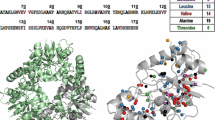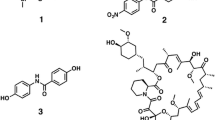Abstract
Chemical modification is an easy way for stable isotope labeling of non-labeled proteins. The reductive 13C-methylation of the amino group of the lysine side-chain by 13C-formaldehyde is a post-modification and is applicable to most proteins since this chemical modification specifically and quickly proceeds under mild conditions such as 4 °C, pH 6.8, overnight. 13C-methylation has been used for NMR to study the interactions between the methylated proteins and various molecules, such as small ligands, nucleic acids and peptides. Here we applied lysine 13C-methylation NMR to monitor protein–protein interactions. The affinity and the intermolecular interaction sites of methylated ubiquitin with three ubiquitin-interacting proteins were successfully determined using chemical-shift perturbation experiments via the 1H–13C HSQC spectra of the 13C-methylated-lysine methyl groups. The lysine 13C-methylation NMR results also emphasized the importance of the usage of side-chain signals to monitor the intermolecular interaction sites, and was applicable to studying samples with concentrations in the low sub-micromolar range.








Similar content being viewed by others
References
Abraham SJ, Hoheisel S, Gaponenko V (2008) Detection of protein-ligand interactions by NMR using reductive methylation of lysine residues. J Biomol NMR 42:143–148
Abraham SJ, Kobayashi T, Solaro RJ, Gaponenko V (2009) Differences in lysine pKa values may be used to improve NMR signal dispersion in reductively methylated proteins. J Biomol NMR 43:239–246
Baker EN, Hubbard RE (1984) Hydrogen-bonding in globular-proteins. Prog Biophys Mol Biol 44:97–179
Bokoch MP, Zou YZ, Rasmussen SGF, Liu CW, Nygaard R, Rosenbaum DM, Fung JJ, Choi HJ, Thian FS, Kobilka TS, Puglisi JD, Weis WI, Pardo L, Prosser RS, Mueller L, Kobilka BK (2010) Ligand-specific regulation of the extracellular surface of a G-protein-coupled receptor. Nature 463:108–121
Bradbury JH, Brown LR (1973) Determination of dissociation constants of lysine residues of lysozyme by proton-magnetic-resonance spectroscopy. Eur J Biochem 40:565–576
Brown LR, Bradbury JH (1975) Proton-magnetic-resonance studies of lysine residues of ribonuclease-A. Eur J Biochem 54:219–227
Cavanagh J, Fairbrother WJ, Palmer AG, Rance M, Skelton NJ (2007) Protein NMR spectroscopy, 2nd edn. Academic Press, Inc., San Diego
Chakrabarti P, Janin J (2002) Dissecting protein–protein recognition sites. Proteins 47:334–343
Ciani B, Layfield R, Cavey JR, Sheppard PW, Searle MS (2003) Structure of the ubiquitin-associated domain of p62 (SQSTM1) and implications for mutations that cause Paget’s disease of bone. J Biol Chem 278:37409–37412
Delaglio F, Grzesiek S, Vuister GW, Zhu G, Pfeifer J, Bax A (1995) NMRPipe—a multidimensional spectral processing system based on unix pipes. J Biomol NMR 6:277–293
Dick LR, Sherry AD, Newkirk MM, Gray DM (1988) Reductive methylation and C-13 NMR-studies of the lysyl residues of fd gene 5 protein—lysine-24, lysine-46 and lysine-69 may be involved in nucleic-acid binding. J Biol Chem 263:18864–18872
Dick LR, Geraldes C, Sherry AD, Gray CW, Gray DM (1989) C-13 NMR of methylated lysines of fd gene-5 protein—evidence for a conformational change involving lysine-24 upon binding of a negatively charged lanthanide chelate. Biochemistry 28:7896–7904
Esadze A, Li DW, Wang TZ, Bruschweiler R, Iwahara J (2011) Dynamics of lysine side-chain amino groups in a protein studied by heteronuclear H-1-N-15 NMR spectroscopy. J Am Chem Soc 133:909–919
Fraczkiewicz R, Braun W (1998) Exact and efficient analytical calculation of the accessible surface areas and their gradients for macromolecules. J Comput Chem 19:319–333
Funakoshi M, Sasaki T, Nishimoto T, Kobayashi H (2002) Budding yeast Dsk2p is a polyubiquitin-binding protein that can interact with the proteasome. Proc Natl Acad Sci USA 99:745–750
Gerken TA (1984) Amino group environments and metal-binding properties of C-13 reductively methylated bovine alpha-lactalbumin. Biochemistry 23:4688–4697
Gerken TA, Jentoft JE, Jentoft N, Dearborn DG (1982) Intramolecular interactions of amino-groups in C-13 reductively methylated hen egg-white lysozyme. J Biol Chem 257:2894–2900
Goddard TD, Kneller DG (1999) SPARKY3. University of California, San Francisco
Isogai S, Morimoto D, Arita K, Unzai S, Tenno T, Hasegawa J, Sou Y-s, Komatsu M, Tanaka K, Shirakawa M, Tochio H (2011) Crystal structure of the ubiquitin-associated (UBA) domain of p62 and its interaction with ubiquitin. J Biol Chem 286:31864–31874
Jentoft N, Dearborn DG (1983) Protein labeling by reductive alkylation. Method Enzymol 91:570–579
Jentoft JE, Jentoft N, Gerken TA, Dearborn DG (1979) C-13 NMR-studies of ribonuclease-a methylated with formaldehyde-C-13. J Biol Chem 254:4366–4370
Johnston SC, Riddle SM, Cohen RE, Hill CP (1999) Structural basis for the specificity of ubiquitin C-terminal hydrolases. EMBO J 18:3877–3887
Kay LE (2011) Solution NMR spectroscopy of supra-molecular systems, why bother? A methyl-TROSY view. J Magn Reson 210:159–170
Kay LE, Keifer P, Saarinen T (1992) Pure absorption gradient enhanced heteronuclear single quantum correlation spectroscopy with improved sensitivity. J Am Chem Soc 114:10663–10665
Kigawa T, Muto Y, Yokoyama S (1995) Cell-free synthesis and amino acid-selective stable-isotope labeling of proteins for NMR analysis. J Biomol NMR 6:129–134
Kumar S, Nussinov R (2002) Close-range electrostatic interactions in proteins. ChemBioChem 3:604–617
Liu JJ, Horst R, Katritch V, Stevens RC, Wuethrich K (2012) Biased signaling pathways in beta(2)-adrenergic receptor characterized by F-19-NMR. Science 335:1106–1110
Long J, Garner TP, Pandya MJ, Craven CJ, Chen P, Shaw B, Williamson MP, Layfield R, Searle MS (2010) Dimerisation of the UBA domain of p62 inhibits ubiquitin binding and regulates NF-kappa B signalling. J Mol Biol 396:178–194
Macdonald JM, LeBlanc DA, Haas AL, London RE (1999) An NMR analysis of the reaction of ubiquitin with acetyl-1-C-13 aspirin. Biochem Pharmacol 57:1233–1244
Moore GR, Cox MC, Crowe D, Osborne MJ, Rosell FI, Bujons J, Barker PD, Mauk MR, Mauk AG (1998) N-epsilon, N-epsilon-dimethyl-lysine cytochrome c as an NMR probe for lysine involvement in protein–protein complex formation. Biochem J 332:439–449
Mori S, Abeygunawardana C, Johnson MO, Vanzijl PCM (1995) Improved sensitivity of HSQC spectra of exchanging protons at short interscan delays using a new fast HSQC (FHSQC) detection scheme that avoids water saturation. J Magn Reson B 108:94–98
Ofran Y, Rost B (2003) Analysing six types of protein–protein interfaces. J Mol Biol 325:377–387
Ohno A, Jee J, Fujiwara K, Tenno T, Goda N, Tochio H, Kobayashi H, Hiroaki H, Shirakawa M (2005) Structure of the UBA domain of Dsk2p in complex with ubiquitin: molecular determinants for ubiquitin recognition. Structure 13:521–532
Rayment I (1997) Reductive alkylation of lysine residues to alter crystallization properties of proteins. Methods Enzymol 276:171–179
Religa TL, Ruschak AM, Rosenzweig R, Kay LE (2011) Site-directed methyl group labeling as an NMR probe of structure and dynamics in supramolecular protein systems: applications to the proteasome and to the CIpP protease. J Am Chem Soc 133:9063–9068
Sakamoto T, Tanaka T, Ito Y, Rajesh S, Iwamoto-Sugai M, Kodera Y, Tsuchida N, Shibata T, Kohno T (1999) An NMR analysis of ubiquitin recognition by yeast ubiquitin hydrolase: evidence for novel substrate recognition by a cysteine protease. Biochemistry 38:11634–11642
Sattler M, Schleucher J, Griesinger C (1999) Heteronuclear multidimensional NMR experiments for the structure determination of proteins in solution employing pulsed field gradients. Prog Nucl Magn Reson 34:93–158
Sherry AD, Teherani J (1983) Physical studies of C-13-methylated concanavalin-A—pH-induced and Co2+-induced nuclear magnetic-resonance shifts. J Biol Chem 258:8663–8669
Takahashi H, Shimada I (2010) Production of isotopically labeled heterologous proteins in non-E. coli prokaryotic and eukaryotic cells. J Biomol NMR 46:3–10
Vijaykumar S, Bugg CE, Cook WJ (1987) Structure of ubiquitin refined at 1.8 Å resolution. J Mol Biol 194:531–544
Walter TS, Meier C, Assenberg R, Au KF, Ren JS, Verma A, Nettleship JE, Owens RJ, Stuart DI, Grimes JM (2006) Lysine methylation as a routine rescue strategy for protein crystallization. Structure 14:1617–1622
Wishart DS, Bigam CG, Yao J, Abildgaard F, Dyson HJ, Oldfield E, Markley JL, Sykes BD (1995) H-1, C-13 and N-15 chemical-shift referencing in biomolecular NMR. J Biomol NMR 6:135–140
Ye Y, Godzik A (2003) Flexible structure alignment by chaining aligned fragment pairs allowing twists. Bioinformatics 19:246–255
Zandarashvili L, Li DW, Wang TZ, Bruschweiler R, Iwahara J (2011) Signature of mobile hydrogen bonding of lysine side chains from long-range N-15-C-13 scalar J-couplings and computation. J Am Chem Soc 133:9192–9195
Zhang MJ, Vogel HJ (1993) Determination of the side-chain pK(a) values of the lysine residues in calmodulin. J Biol Chem 268:22420–22428
Zuiderweg ERP (2002) Mapping protein–protein interactions in solution by NMR spectroscopy. Biochemistry 41:1–7
Acknowledgments
We thank M. Yoneyama and H. Kinoshita for sample preparation; S. Isogai and D. Morimoto for the gift of the p62UBA sample; H. Kobayashi and A. Ohno for the gift of the Dsk2UBA expression vector; and J. Tsukamoto, Y. Hara and A. Nakagawa for mass spectroscopy. This work was supported in part by grants from the Ministry of Education, Culture, Sports, Science and Technology (MEXT) through the Target Proteins Research Program, the Global COE Program at NAIST, and Grants-in-Aid for Scientific Research (20370038, 22121515, 23370053, 20770086) to CK and IO.
Author information
Authors and Affiliations
Corresponding authors
Electronic supplementary material
Below is the link to the electronic supplementary material.
Rights and permissions
About this article
Cite this article
Hattori, Y., Furuita, K., Ohki, I. et al. Utilization of lysine 13C-methylation NMR for protein–protein interaction studies. J Biomol NMR 55, 19–31 (2013). https://doi.org/10.1007/s10858-012-9675-9
Received:
Accepted:
Published:
Issue Date:
DOI: https://doi.org/10.1007/s10858-012-9675-9




